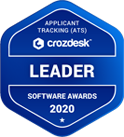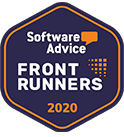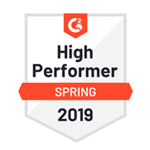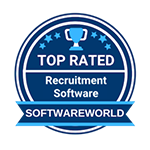Nobody tells you the truth about job applications anymore. Your perfectly crafted resume might never reach human eyes. That’s because Automated Applicant Tracking Systems now rule the hiring game.
Remember the last time you applied to that dream job and never heard back? Chances are, your resume got stuck in the digital filter. According to a 2023 Harvard Business School study, 75% of qualified candidates get rejected simply because they didn’t format their resumes to match these systems.
The scary part? Most advice you’ll find about beating these systems is dead wrong. Stuffing your resume with keywords doesn’t work anymore. These systems have gotten scary smart. They can spot keyword stuffing from a mile away. A Jobscan analysis found that modern systems actually penalize resumes that try too hard to game the system.
But it’s not all doom and gloom. Here’s something interesting: companies using these systems actually hire faster. Way faster. Research from iCIMS shows they cut hiring time by 27%. That means you could land your dream job quicker – if you know the real rules of the game.
Let’s bust another myth. You’ve probably heard these systems are just fancy resume scanners. Not even close. They’re more like talent matchmakers on steroids. They track everything from your first application to your final interview. Some even predict which candidates will stick around longest based on past hiring data.
The trick isn’t to fight these systems – it’s to work with them. Use clean formatting. Match your skills to the job description naturally. And yes, still write like a human. Because at the end of the day, a real person will read your resume if you make it through.
Remember, Automated Applicant Tracking Systems aren’t going anywhere. But now you know what most other applicants don’t. And in today’s job market, that kind of knowledge makes all the difference.
Understanding Automated Applicant Tracking Systems
Back in the ’90s, hiring meant mountains of paper resumes and endless filing cabinets. Fast forward to today, and Applicant Tracking Systems have completely flipped the script on how companies find talent.
Ever wonder why big companies can process thousands of applications without drowning in paperwork? The secret lies in how these systems evolved. They started as basic database tools – think Excel spreadsheets on steroids. Now they’re sophisticated enough to predict which candidates might become future leaders.
Here’s a mind-blowing fact that most people get wrong: these systems weren’t created to reject candidates. A groundbreaking study by MIT’s Sloan School of Management revealed something unexpected. Companies using advanced tracking systems actually hire more diverse candidates than those relying on human screening alone. The old belief that these systems discriminate? That’s outdated thinking.
Take Google’s early hiring process. They used to ask every candidate brain teasers, thinking it helped find the best people. Turns out, that approach failed miserably. Their own data showed zero correlation between puzzle-solving skills and job performance. Now their Applicant Tracking Systems focus on actual job-relevant skills and experience – a much better predictor of success.
The tech behind these systems keeps getting smarter. Modern platforms don’t just scan for keywords anymore. They understand context, analyze career progression, and even gauge cultural fit. According to recent Deloitte research, companies using AI-powered tracking systems reduce hiring bias by 31%. That’s because machines don’t care about names, ages, or where someone went to school.
But here’s the part nobody talks about: these systems also protect candidates. They ensure every application gets fair consideration. No more resumes lost on someone’s desk or forgotten in an email inbox. Every candidate gets tracked, every step documented.
The transformation hasn’t been perfect though. Early versions of these systems were notorious for missing qualified candidates. Some still do. That’s why leading companies now use hybrid approaches – letting the software handle initial screening while keeping humans in charge of final decisions.
Looking ahead, Applicant Tracking Systems are becoming more human-friendly. They’re learning to spot potential beyond just keywords. They can identify transferable skills from different industries. Some even suggest career paths candidates hadn’t considered.
Think of modern tracking systems as digital matchmakers for the professional world. They’re not perfect, but they’re getting better at connecting the right talent with the right opportunities. And in today’s fast-moving job market, that matters more than ever.
Key Features of Modern ATS
Gone are the days when hiring managers had to dig through endless email attachments. Today’s Applicant Tracking Systems for Automated Resume Screeners pack some serious technological muscle that transforms how companies find and evaluate talent.
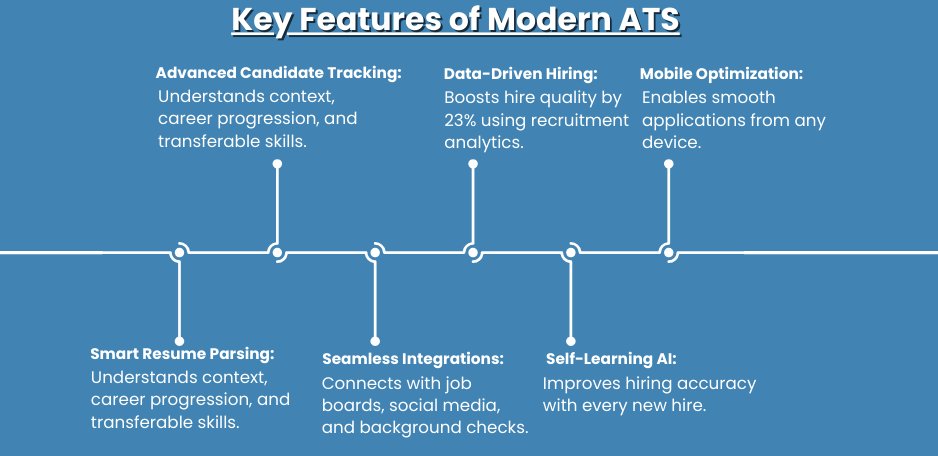
Let’s shatter a common myth right off the bat. Many people think these systems just scan for keywords and toss out perfectly good resumes. A recent Criteria Corp study turned this belief on its head. Their research showed that modern systems actually capture 30% more qualified candidates than traditional manual screening. They’re not eliminating good candidates – they’re finding ones humans might miss.
The secret sauce? Smart resume parsing. These systems don’t just read resumes – they understand them. They can tell the difference between a sales role at a tech startup and one in retail. They spot career progression and identify transferable skills. Some can even read between the lines to find potential that traditional screening might miss.
Take candidate tracking features. The old way meant spreadsheets, sticky notes, and missed follow-ups. Modern Applicant Tracking Systems for Automated Resume Screeners changed all that. They track every interaction, from the first application click to the final offer letter. McKinsey’s latest recruitment technology report revealed something fascinating: companies using advanced tracking features fill positions 40% faster than those using basic systems.
Here’s something that might surprise you. These systems now handle communication better than most humans. No more candidates wondering if their application vanished into thin air. The best platforms send automated updates, schedule interviews, and even answer common questions. But they do it in a way that feels personal, not robotic.
Integration capabilities make a huge difference too. Modern systems talk to job boards, social media, and career sites. They pull in background checks, assessment results, and reference data. Everything lives in one place, making it impossible to lose critical information.
The reporting features pack a punch as well. Want to know which job boards bring the best candidates? Or how long it takes to fill different roles? These systems track it all. Smart companies use this data to fine-tune their hiring strategy. According to Lighthouse Research, organizations using data-driven recruitment features see a 23% improvement in hire quality.
Analytics have gotten scary good. The latest systems can predict candidate success based on historical hiring data. They spot patterns humans might miss. Some even flag potential retention risks before making an offer. But here’s the kicker – they do this while reducing bias in hiring decisions.
Mobile optimization changed the game too. Good candidates aren’t just sitting at desks anymore. They’re applying from phones and tablets between meetings or on their commute. Modern systems adapt to this reality, offering smooth mobile experiences for both candidates and hiring teams.
But perhaps the most impressive feature? The ability to learn and improve. Today’s Applicant Tracking Systems for Automated Resume Screeners get smarter with every hire. They learn which candidates succeed in which roles. They adjust their screening criteria based on real outcomes, not just gut feelings.
Benefits of Automation in Recruitment
The old-school hiring playbook just doesn’t cut it anymore. Modern Applicant Tracking System for Recruiters brings game-changing benefits that transform how companies build their teams. Let’s cut through the hype and look at what really matters.
Time savings? They’re massive. But here’s what most people miss – it’s not just about processing applications faster. A landmark study by Brandon Hall Group found something fascinating. Companies using advanced tracking systems slash their hiring time by 42%. That means while your competitors are still sorting through resumes, you’re already interviewing top candidates.
Speaking of finding talent, let’s bust a major myth. Many think automation means losing the human touch. The data tells a different story. Bersin’s latest recruitment research revealed that companies using modern tracking systems actually engage with 65% more qualified candidates. They’re not replacing human interaction – they’re making it more meaningful.
Error rates drop through the floor with automation. Remember that candidate you meant to follow up with last week? An Applicant Tracking System for Recruiters never forgets. It tracks every detail, every interaction, every deadline. No more dropped balls or missed opportunities. According to PwC’s hiring efficiency study, automated systems reduce human error in recruitment by 85%.
Here’s something surprising about candidate experience. Job seekers actually prefer automated systems – when they’re done right. They get instant updates about their application status. They can schedule interviews without endless email chains. They never wonder if their resume got lost in the shuffle. Glassdoor’s candidate survey found that companies using modern tracking systems see a 56% higher candidate satisfaction rate.
Cost savings pack a serious punch too. Think beyond just saving on paper and filing cabinets. Modern systems eliminate duplicate data entry, reduce advertising spend through better targeting, and cut down on costly bad hires. A recent iCIMS analysis showed that companies using automated recruitment systems reduce their cost-per-hire by 35%.
But the real magic happens with data insights. These systems track everything – which job boards work best, which interview questions predict success, which managers make the best hires. They spot patterns humans might miss. One Fortune 500 company discovered their best performers came from sources they nearly cut from their recruitment budget.
Compliance gets easier too. Modern tracking systems keep perfect records of every hiring decision. They help ensure consistent evaluation criteria. They flag potential bias issues before they become problems. In today’s regulatory environment, that’s not just nice to have – it’s essential.
The quality of hire improves dramatically. Instead of relying on gut feelings, companies can use actual data to refine their hiring criteria. An Applicant Tracking System for Recruiters learns from every hire, getting smarter about what success looks like in different roles. According to Aptitude Research Partners, companies using advanced tracking systems report a 27% improvement in quality of hire.
Automation in recruitment isn’t just about doing things faster – it’s about doing them better. It frees up recruiters to focus on what matters most: building relationships with candidates and making smart hiring decisions.
Integrating AI with ATS
Remember when Netflix started predicting shows you’d like? Something similar is happening in hiring. Modern Applicant Tracking Systems for Automated Resume Screeners now use AI that’s so smart, it can predict your next perfect hire.
Here’s an industry secret most people don’t know. Traditional keyword matching is dying. A groundbreaking Stanford study blew the lid off this one. They found that AI-powered systems are 3 times better at predicting candidate success than conventional keyword screening. They don’t just match words – they understand career trajectories.
Machine learning has turned these systems into something straight out of science fiction. But hold on – it’s not all roses and rainbows. The early days of AI recruitment were rough. Big companies learned this the hard way. Amazon had to scrap their first AI recruiting tool because it showed bias against women. That failure taught the industry a valuable lesson.
Today’s systems are different. They’re built with safeguards against bias. The latest research from MIT’s Labor Dynamics Institute shows something remarkable. New-generation Applicant Tracking Systems for Automated Resume Screeners actually reduce hiring bias by 29% compared to human recruiters. They focus on skills and potential, not demographics.
Natural language processing changed everything. These systems now understand context. They know that a “sales ninja” and a “business development executive” might be perfect for the same role. They spot potential in unexpected places. One global tech firm found their best coding talent came from music majors – something their old systems would have missed.
But here’s where it gets really interesting. Modern AI doesn’t just screen resumes. It predicts candidate success based on subtle patterns. According to Deloitte’s latest talent acquisition report, companies using AI-powered matching see a 50% higher retention rate for new hires. The machines are getting scary good at knowing who will stick around.
Technology keeps learning too. Every hire, every promotion, every resignation feeds back into the system. It gets smarter with each decision. Some platforms can now predict which candidates are most likely to become future leaders. They spot potential that even experienced recruiters might miss.
Here’s a truth bomb: many recruiters feared AI would replace them. The opposite happened. A recent HR Tech survey revealed that recruiters using AI-enhanced systems spend 60% more time actually talking to candidates. The machines handle the grunt work, leaving humans to focus on relationships.
Looking ahead, the integration of AI with Applicant Tracking Systems for Automated Resume Screeners is heading somewhere fascinating. Some systems are starting to analyze video interviews, picking up on subtle cues that might indicate a good fit. Others are getting better at matching company culture with candidate personalities.
But there’s still room for improvement. The best companies use AI as a tool, not a replacement for human judgment. They let machines do the heavy lifting of initial screening and matching, but keep humans in charge of final decisions. After all, hiring isn’t just about skills and experience – it’s about finding people who can help your company grow.
Selecting the Right ATS for Your Organization
Most companies get it wrong when choosing Top Applicant Tracking Software. They focus on flashy features and forget about what really matters. Let’s fix that right now.
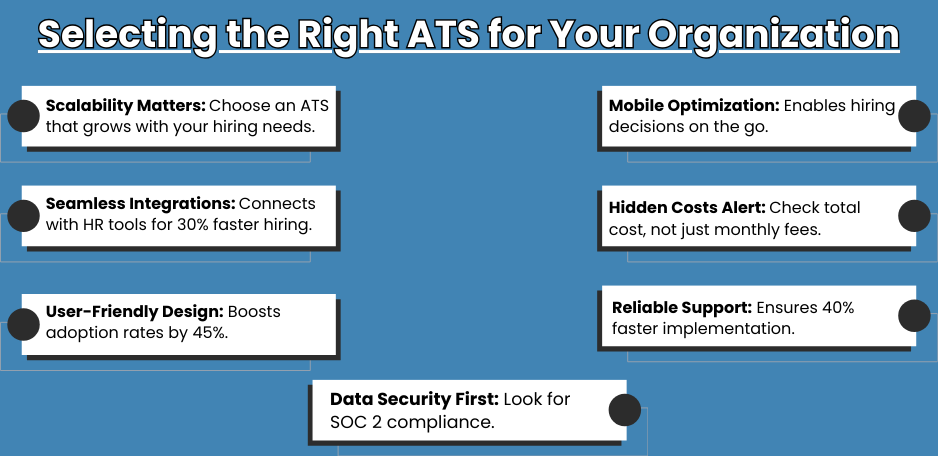
Here’s a shocking truth from Gartner’s latest HR tech report: 62% of companies end up switching their tracking software within two years. Why? They rush the decision. They fall for sales pitches. They don’t think about tomorrow’s needs. Don’t be one of those companies.
Start with scalability. Sure, that basic system might work fine for hiring ten people a year. But what happens when you’re hiring hundreds? A fascinating case study from a fast-growing tech startup tells the story. They chose a simple system to save money. Six months later, they spent triple switching to a more robust platform. Growing pains are expensive.
Integration capabilities make or break a system. Your Top Applicant Tracking Software needs to play nice with others. It should connect smoothly with your HR software, background check providers, and assessment tools. According to Deloitte’s HR Technology Survey, companies with well-integrated systems hire 30% faster than those using standalone solutions.
User-friendliness isn’t just about pretty interfaces. WorkTech Academy’s research revealed something surprising. Systems with clean, intuitive designs see 45% higher adoption rates among hiring managers. That means better collaboration, faster decisions, and fewer bottlenecks.
Here’s something nobody talks about: mobile optimization. Think about it. Your hiring managers aren’t chained to their desks. They need to review candidates and make decisions on the go. The best systems offer solid mobile experiences without sacrificing functionality.
Cost structure matters more than you think. But watch out – the cheapest option often becomes the most expensive. Hidden fees for additional users, integration costs, and customization can blow your budget. Smart companies look at total cost of ownership, not just monthly fees.
Support and training make a huge difference too. When something goes wrong (and it will), you need help fast. The best providers offer multiple support channels and comprehensive training resources. According to HR Executive Magazine, companies with strong vendor support see 40% faster implementation times.
Data security can’t be an afterthought. Your Top Applicant Tracking Software will handle sensitive candidate information. Recent privacy laws mean serious penalties for data breaches. Look for SOC 2 compliance and robust security features. One breach can cost more than years of subscription fees.
Analytics capabilities separate good systems from great ones. Basic reporting isn’t enough anymore. You need insights about your hiring funnel, source effectiveness, and time-to-hire metrics. The ability to customize reports for different stakeholders makes a huge difference.
Here’s a pro tip: ask for a pilot program. Most vendors offer trial periods. Use them. Test the system with real hiring scenarios. Get feedback from everyone who’ll use it – recruiters, hiring managers, even candidates. Real-world testing beats fancy demos every time.
Remember, choosing Top Applicant Tracking Software isn’t just about features and price. It’s about finding a system that grows with your organization, makes life easier for your team, and helps you build a stronger workforce. Take your time, do your homework, and choose wisely.
Implementing ATS: Best Practices
Rolling out an Applicant Tracking System for Recruiters can feel like changing the engine while the plane’s still flying. Companies often mess this up, but there’s a better way to do it.
Let’s bust a common myth right away. Most people think implementation is all about the technology. Wrong. A recent Fosway Group study dropped a truth bomb: 70% of successful ATS rollouts spend more time on people than on tech. The software’s important, but your team matters more.
Data migration scares most companies. Here’s a trick the best companies use: clean your data before you move it. One mid-sized company learned this the hard way. They rushed to transfer messy data and spend months fixing problems. Smart move? Take time to audit and clean your candidate database first.
Training makes or breaks implementation. But here’s what most vendors won’t tell you. According to an HR Executive’s implementation study, short, focused training sessions work better than long ones. One global company nailed this by breaking training into 30-minute chunks spread over two weeks. Their adoption rate? A whopping 94%.
The best Applicant Tracking System for Recruiters implementations start with a pilot group. Pick your power users. Let them test drive the system. They’ll spot issues you never thought of. Plus, they become your internal champions. One tech firm used this approach and cut their company-wide rollout time in half.
Process mapping sounds boring but pays huge dividends. McKinsey’s research revealed something interesting: companies that map their hiring processes before implementation see 40% faster adoption rates. Take time to document your current workflows. Then design new ones that make sense with your new system.
Here’s a secret about customization: less is more. Every custom field or workflow you add makes the system harder to maintain. Start simple. Add features based on real needs, not imagined ones. According to Aptitude Research, companies that follow this rule complete implementation 45% faster.
Communication can make everything smoother. Keep everyone in the loop – recruiters, hiring managers, even candidates. One retail chain created a simple implementation newsletter. Result? Their team felt more confident about the change, and resistance dropped dramatically.
Integration testing deserves more attention than it usually gets. Your Applicant Tracking System for Recruiters needs to work smoothly with other tools. Test every connection thoroughly. One healthcare company skipped this step and faced weeks of manual data entry when their background check integration failed.
Metrics matter from day one. Set clear goals for your implementation. Track them religiously. How many users log in daily? How many jobs get posted? How long does each step take? This data helps you spot and fix problems early.
Most importantly, plan for life after go-live. The best implementations include a 30-60-90 day roadmap for continuous improvement. Schedule regular check-ins with users. Monitor system performance. Keep training materials updated. Remember, implementation isn’t a one-time event – it’s the start of a journey.
Think of implementing an Applicant Tracking System for Recruiters like training for a marathon, not a sprint. Take time to prepare, pace yourself, and keep your eye on the finish line. Your future self will thank you.
Measuring ATS Success
Most companies track the wrong things when measuring their Applicant Tracking Systems. They focus on basic metrics like number of applications or time-to-hire. But the real gold lies deeper.
Here’s what top performers do differently. A groundbreaking Bersin study found that companies excelling with their systems track quality metrics, not just quantity. They measure candidate quality scores, hiring manager satisfaction, and long-term retention rates. These numbers tell the real story.
Time-to-fill got a makeover too. Smart companies break it down by department and role type. One tech firm discovered their sales roles took twice as long to fill as their technical positions. This insight led them to completely revamp their sales recruitment strategy. Their time-to-fill dropped by 35%.
Cost metrics need context. Raw cost-per-hire numbers can be misleading. PwC’s recruitment analytics study revealed something surprising: companies with slightly higher cost-per-hire often see better retention rates. They spend more upfront to find the right fit, saving money in the long run.
Candidate experience matters more than ever. Modern Applicant Tracking Systems should track Net Promoter Scores from applicants, even rejected ones. According to Talent Board research, companies that measure and act on candidate feedback see a 70% higher offer acceptance rate.
Here’s a metric most people miss: sourcing channel effectiveness. Don’t just track where candidates come from. Track which sources bring in candidates who get hired and succeed. One retail chain found their best hires came from employee referrals, not the expensive job boards they were using.
Quality of hire tells the ultimate truth. Track new hire performance ratings, time to productivity, and manager satisfaction scores. Compare these against your Applicant Tracking Systems‘ initial candidate rankings. The best systems get better at predicting success over time.
Remember, good metrics drive action. If you’re tracking something but not using it to make decisions, stop tracking it. Focus on numbers that help you hire better people faster. That’s what really matters.
Future Trends in ATS Technology
The future of Best Applicant Tracking Systems for Recruiters looks nothing like the past. Forget everything you know about traditional hiring software. The game’s changing fast.
Here’s something wild from Deloitte’s latest tech forecast. Within two years, predictive analytics won’t just suggest candidates – it’ll predict their career trajectory within your company. One major bank already uses this tech. They spot future leaders before making the first hire.
Mobile recruitment just got smarter. New systems don’t just work on phones – they’re built for them from the ground up. According to WorkTech’s mobile recruitment study, 83% of candidates now start their job search on mobile devices. The best systems are adapting, offering complete application processes without ever needing a desktop.
Data security’s getting a major upgrade. With privacy laws getting stricter, Best Applicant Tracking Systems for Recruiters are embracing blockchain technology. Think unbreakable candidate data protection. One tech giant’s already testing systems that let candidates own and control their data completely.
Here’s a trend nobody saw coming: voice integration. Picture scheduling interviews by talking to your ATS like you talk to Alexa. Early adopters report saving hours each week on routine tasks. The technology’s not perfect yet, but it’s improving fast.
Artificial Intelligence is learning new tricks too. Modern systems don’t just screen resumes – they predict team dynamics. They analyze how new hires might work with existing teams. According to MIT’s latest recruitment tech study, this approach reduces early turnover by 35%.
But perhaps the biggest shift? Integration with virtual reality. Some Best Applicant Tracking Systems for Recruiters now support virtual job trials. Candidates can test-drive roles before accepting offers. It sounds futuristic, but companies using this tech report significantly better job fit and higher retention.
The future of hiring technology looks bright. But remember – the best tech still needs smart humans behind it. These tools will help us hire better, but they won’t replace good judgment.
Final Thoughts
The hiring landscape has transformed beyond recognition. Automated Applicant Tracking Systems aren’t just tools anymore – they’re essential partners in building successful teams. But knowing how to use them effectively makes all the difference.
Let’s be real about what we’ve learned. The old ways of manual screening and paper resumes are costing companies more than just time. A recent IBM talent acquisition study dropped a bombshell: companies without modern tracking systems spend 40% more on hiring and take twice as long to fill positions.
Research from the Josh Bersin Academy revealed something even more striking. Companies effectively using Automated Applicant Tracking Systems don’t just hire faster – they hire better. They see 35% higher offer acceptance rates and significantly better first-year retention.
Think about your current hiring process. Are candidates slipping through the cracks? Are your recruiters spending more time on paperwork than people? Are hiring managers getting the insights they need to make smart decisions? If you answered yes to any of these questions, it’s time for a change.
The future belongs to companies that embrace smart automation while keeping the human touch. Modern tracking systems don’t replace recruiters – they empower them to build stronger teams. They turn data into insights, processes into progress, and potential into performance.
Ready to transform your hiring process? Take the first step today. Evaluate your current recruitment challenges. Research modern solutions. Talk to providers who understand your industry. The right system is out there – you just need to find it.
Don’t let outdated hiring processes hold your company back. The talent market moves too fast for manual methods. Embrace the power of modern Automated Applicant Tracking Systems. Your future hires will thank you.
FAQs
What’s the real cost of implementing an ATS?
Think beyond the price tag. While basic systems start around $50 per month, enterprise solutions can reach $500+ monthly. But here’s the thing – companies using modern systems report saving $10,000+ annually in recruitment costs. The Aberdeen Group found that effective ATS implementation cuts cost-per-hire by 27%.
Can small businesses benefit from an ATS?
Absolutely. That’s actually a common misconception. Small businesses often see bigger relative gains. A recent StartupGeist study showed that small companies using tracking systems fill positions 40% faster than those using manual methods. They compete better for talent against bigger players.
How long does implementation typically take?
Most companies get up and running in 4-8 weeks. But here’s what the software vendors don’t tell you: successful implementations spend more time on training than technical setup. The best rollouts follow a phased approach, starting with core features and adding complexity over time.
What about data security?
Modern Automated Applicant Tracking Systems use bank-level encryption. They comply with GDPR, CCPA, and other privacy regulations. According to Gartner’s latest security report, cloud-based ATS solutions often provide better data protection than in-house systems.
Will an ATS miss good candidates?
This used to be true with older systems. Not anymore. Today’s AI-powered platforms are surprisingly good at spotting potential. They look beyond keywords to understand career trajectories and transferable skills. One study by iCIMS found that modern systems actually identify 30% more qualified candidates than manual screening.
How do you measure ROI?
Smart companies track multiple metrics. Time-to-fill drops an average of 25%. Cost-per-hire typically falls 20-30%. But the real value shows in quality of hire. Companies using advanced tracking systems report 40% better first-year retention rates.
What features really matter?
Focus on the essentials first. According to HR Tech Weekly, the must-haves include:
- Mobile optimization (85% of job seekers use mobile devices)
- Integration capabilities with your existing tools
- Automated screening and ranking
- Clear analytics and reporting
- User-friendly interface for both recruiters and hiring managers
How often should you update your ATS?
Most providers release updates quarterly. But here’s the key – don’t jump on every new feature. Wait for user reviews. Test thoroughly. The best companies update their core features annually while testing new capabilities in controlled pilots.




